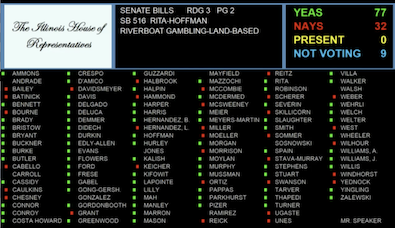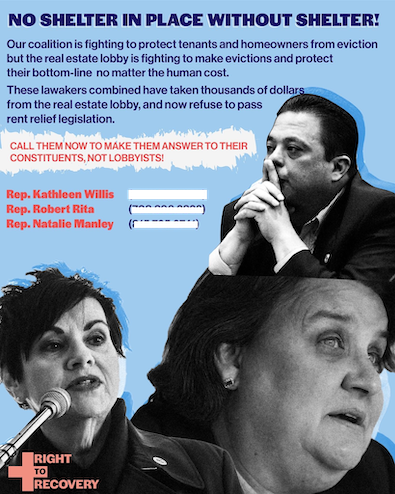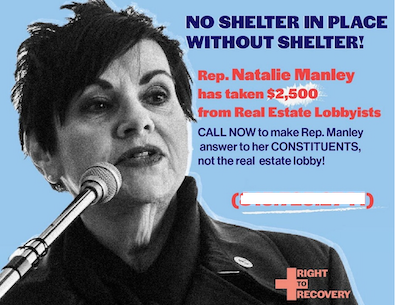Sunday programming note
Saturday, May 23, 2020 - Posted by Rich Miller
* If the House and Senate finish up work tonight, I won’t be blogging tomorrow, except about this…
Daily Public Schedule: Sunday, May 24, 2020
What: Gov. Pritzker to hold press availability.
Where: Illinois State Capitol, Governor’s Office, Springfield
When: 11:00 a.m.
Watch live: https://www.Illinois.gov/LiveVideo
Since this will not be a COVID-19 media briefing, I won’t be covering it live like I usually do. I will, however, post something about it.
And if one or both legislative chambers do convene tomorrow, I will be blogging as usual.
Comments Off  
|
* Sen. Rob Martwick (D-Chicago) decided not to come to Springfield because he has some health issues that put him at increased risk if he catches the COVID-19 virus. But the Senate just added Martwick to the roll call and he confirmed to me that he is in Springfield.
More in a bit.
…Adding… “I was told they needed one more vote,” Martwick told me. That one vote, he said, was for the gaming bill.
“They’re not making me go to the floor,” Martwick explained. There’s apparently a gentleman’s agreement not to verify the roll call so Martwick doesn’t have to actually push his button.
“We really need that casino,” Martwick said, in order to keep the city’s first responder pension funds from going completely broke.
Chicago Mayor Lori Lightfoot and Martwick tussled during last year’s mayoral campaign. She owes him a big one.
…Adding… The agreement not to verify a medically vulnerable Senator has precedent. Sen. Bill Haine was very ill in 2017 when he came back to Springfield to vote to override Gov. Rauner’s veto of the budget and income tax hike. He never left his office.
But this also means 8 Democratic Senators refused to take one for the team to spare Martwick from returning to the Statehouse (40 Senate Democrats minus the three who couldn’t return equals 37 and the rollcall was at 29).
*** UPDATE *** The Senate passed the gaming bill 42-14. That’s final passage. On to the governor’s desk. And they didn’t need Martwick.
…Adding… Roll call…
…Adding… Press release…
Governor JB Pritzker released the following statement after Senate Bill 516 passed the Illinois General Assembly:
“After decades of attempts to build a Chicago casino, I’m proud that by working together this administration and General Assembly has secured its future and paved a path forward for hundreds of millions of dollars annually to repair our schools, hospitals and higher education buildings across the entire state of Illinois. I look forward to signing this legislation that provides a reliable funding stream to our historic $45 billion Rebuild Illinois capital program, and I thank the bipartisan members of the legislature as well as Mayor Lightfoot for bringing this bill across the finish line. Together, we are creating jobs and rebuilding our state.”
Press release…
STATEMENT FROM MAYOR LIGHTFOOT ON PASSAGE OF CHICAGO CASINO BILL
“With critical votes this evening, the Illinois state legislature has passed a bill that makes the possibility of a financially viable Chicago casino a reality. This moment is decades in the making, and represents a critical step toward shoring up our city’s pension obligations, as well as driving huge levels of infrastructure funding and fueling thousands of new jobs for all of Illinois. We are grateful to many lawmakers in both chambers, especially Illinois House Representatives Bob Rita, Jay Hoffman and Kelly Cassidy and State Senators Bill Cunningham and Kim Lightford, in addition to the leadership in both houses - Speaker Madigan, President Harmon, Leaders Durkin and Brady in particular - who were instrumental in the passage of this important legislation. Additional thanks are due to our partners in organized labor, particularly the Chicago Federation of Labor, and its President, Bob Reiter. Thank you to members of the Chicago City Council. And thank you to our fellow mayors, the restaurant and hospitality industries, and of course to the Governor for his dogged and public support of the bill, and we look forward to him signing this bill into law in the near future.”
17 Comments  
|
* House Amendment 5 to SB2135 added some new language today…
In times of pestilence or an emergency resulting from the effects of enemy attack or threatened enemy attack, members may participate remotely and cast votes in sessions, by joint proclamation of the Speaker of the House of Representatives and the President of the Senate, and committees of either the House of Representatives or Senate may participate remotely pursuant to the rules of the chamber. The House of Representatives and the Senate shall adopt rules for remote participation.
The rules of the chamber may require that a quorum of the members is physically present at the location of the session or the committee meeting. As used in this Section, “participate remotely” means simultaneous, interactive participation in session or committee meeting by members not physically present, through means of communication technologies designed to accommodate and facilitate such simultaneous, interactive participation and where members of the public may view such meetings or sessions. This subsection (b) is inoperative on and after June 1, 2022.
Interesting that the rules “may” mandate a physical quorum.
[Hat tip: Amanda Vinicky]
*** UPDATE 1 *** After what seemed like days of debate, the full bill fell short and is now on Postponed Consideration…

More…
Five Black Caucus members (Ammons, Buckner, Flowers, Meyers-Martin, Tarver) three Downstaters (Ammons, Bristow, Yednock) and suburbanite Stava-Murray.
Rep. Lamont Robinson voted “Present.” Rep. Delia Ramirez did not vote. All other Democratic non-voters have excused absences.
*** UPDATE 2 *** The bill has been amended to remove just about everything except keeping some zoological parks open without charging the public.
*** UPDATE 3 *** I gotta slow down. The bill was amended, but everything is still in it and the zoo stuff has been changed.
*** UPDATE 4 *** Argh!!! The FOIA language has been removed. Remote voting and everything else is still in. I may have a small glass of red wine.
*** UPDATE 5 *** OK, I’m gonna walk away from my computer for five minutes. Remote voting is OUT. Oy.
18 Comments  
|
2,352 new cases, 75 additional deaths
Saturday, May 23, 2020 - Posted by Rich Miller
* There will be no media briefing today…
The Illinois Department of Public Health (IDPH) today announced 2,352 new cases of coronavirus disease (COVID-19) in Illinois, including 75 additional deaths.
- Cook County: 1 female 20s, 1 male 30s, 2 females 50s, 4 males 50s, 6 females 60s, 8 males 60s, 7 females 70s, 8 males 70s, 6 females 80s, 5 males 80s, 1 unknown 80s, 8 females 90s, 2 males 90s
- DuPage County: 1 female 90s, 1 female 100+
- Kane County: 1 male 30s, 1 male 70s
- Lake County: 1 male 60s
- Macon County: 1 male 90s
- Madison County: 2 females 90s, 1 male 90s
- Will County: 2 male 50s, 2 females 80s
- Winnebago County: 1 female 50s, 1 male 70s, 1 female 90s
Currently, IDPH is reporting a total of 107,796 cases, including 4,790 deaths, in 100 counties in Illinois. The age of cases ranges from younger than one to older than 100 years. Within the past 24 hours, laboratories have reported 25,114 specimens for a total of 722,247. The statewide 7-day rolling positivity rate, May14th – May 20th is 13%
*All data are provisional and will change. In order to rapidly report COVID-19 information to the public, data are being reported in real-time. Information is constantly being entered into an electronic system and the number of cases and deaths can change as additional information is gathered.
…Adding… Hospitalization numbers from the governor’s office…
Total COVID patients in hospitals: 3753
Total COVID patients in ICU: 1027
Ventilators used by COVID patients: 607
Comments Off  
|
House approves gaming bill 77-32
Saturday, May 23, 2020 - Posted by Rich Miller
* This is about as close to a miracle as you’re gonna get. Lots of people worked very hard to get this done. On to the Senate…

* A bit more info…
There were so many moving parts to this. The negotiators really did a remarkable job.
…Adding… From the pool report…
Rep. Rob Rita is the sponsor of this casino plan that passed out of the House Executive Committee last night. Floor amendments 5 and 6 were quickly adopted. Amendment six made technical changes to the Danville Casino and Chicago tax rates. Amendment #7 moved out of Rules committee quickly. This would move the application deadline for sports betting licenses back one year (2021). This amendment is also quickly adopted on the floor. Members than pause action for a break and several small groups gathered on the floor. (Rita joined several House Republicans) […]
Amendment #9 was adopted for the casino bill. This moves the deadline for fees from casinos and race tracks to July 2021, instead of this year. Rep. Tim Butler says he appreciates Rita’s hard work on the bill. Rep. Wheeler also thanks all of the staff who worked on the massive gaming bill. Rep. Hoffman recognize the amount of work the General Assembly has put toward gaming bills over the last year. “If you voted for the bill last May, you should be voting for this.” Rep. Moylan asked about revenue sharing in this bill. He says the city of Des Plaines needs some relief. He is mad that isn’t included in the bill. Several other lawmakers thanked Rita for his work with staff on the bill. The House passed SB 516 on a 77-32 vote. The measure now moves to the Senate for approval.
…Adding… A few deets from Ryan Keith…
Chicago Casino:
· Changes the initial 33.3 percent AGR tax to new structure
Reconciliation payment:
· Changes reconciliation payment schedule for casinos from 2 years with interest to 6 years without interest
Moves up new table game tax rate to July 1, 2020, from when the first new casino opens in the original bill
Danville:
· Allows IL Gaming Board to extend the casino application period for six months if a license isn’t granted. [Clarified further in a recent amendment.] Had originally been introduced as SB 3686 by Sen. Scott Bennett
State Fair
· Requires Department of Agriculture to purchase one or more terminal operators to place video gaming terminals at the Illinois and Du Quoin State Fairgrounds.
It also cleaned up/delayed some sports betting deadlines at the request of the Illinois Gaming Board.
13 Comments  
|
* From the Senate pool report today…
SB2052 — Sen. Castro
Concur with House on their amendments (TIF Districts)
Righter: Said the House, “in what I am sure was an unintentional oversight,” left out a community in his district [Charleston] from this bill. He said he and others have been working for a few days to address that issue. He added he was “compelled to support my colleagues” and vote on it despite his community not being included.
SB2683 — Sen. Righter
Adopt an amendment
Floor amendment adopted, moved to third reading
Righter: Carries language that would extend a TIF district in the city of Charleston. Fixes what he pointed out about SB2052.
Lightford: Rise in support. It’s “important that we leave no community out when it comes to TIF and financing to help our communities…glad we did have a vehicle … “
A standing ovation followed the successful vote
* OK, let’s back up a bit. The Charleston TIF would be in Rep. Chris Miller’s (R-Oakland) district. Last weekend…
Yeah. Probably not a good move.
* On Thursday, the House passed SB2052, which didn’t include Charleston’s TIF extension, 97-14. Miller voted against it.
Friday morning…
GOP REBELLION!
A group of House Republicans say they’re fed up with how the General Assembly is addressing the state’s financial woes, and they’ve formed a new caucus to do something about it.
Miller is a member of that new sub-caucus.
Also on Friday, Miller asked the House Executive Committee to advance his own TIF bill for Charleston. It was rejected 5-6, with GOP Rep. Grant Wehrle also voting against it.
House Republican Leader Jim Durkin then personally intervened and Exec unanimously approved sending the bill to the floor.
* Today, Sen. Dale Righter, who also represents Charleston, found a vehicle bill, worked his colleagues hard and passed the stand-alone through his chamber, ultimately receiving a standing ovation for his efforts.
I refer you back to what I wrote on Thursday…
And when Sen. Righter retires, who’s going to advocate for Eastern Illinois University? Who’s going to put in the hard work that Righter did to make sure that part of the world gets its fair share from the state?
Nobody, that’s who, unless Bailey or one of his regional colleagues finally start acting like adults.
And now we wait to see what Rep. Miller (no relation) and the House do about the two Charleston TIF bills awaiting action in the chamber.
*** UPDATE *** The House decided not to take up either bill. So Charleston still doesn’t have its TIF extension.
22 Comments  
|
* Jennifer Smith Richards and Robert McCoppin at the Tribune…
The state has stopped providing total numbers of novel coronavirus cases and deaths linked to long-term care facilities in Illinois, instead disclosing information only on homes with newer outbreaks.
The Illinois Department of Public Health changed its reporting criteria Friday to highlight nursing homes and other facilities that have had at least one new coronavirus case in the last 28 days. Information about homes that struggled with an outbreak earlier in the pandemic but haven’t had recent new cases no longer is being published.
For example, the Tribune reported May 15 that, for the first time, a nursing home outside the Chicago area had reported at least 20 deaths. That was Villa East in Sangamon County, which had 21 workers and residents die of the coronavirus.
But because Villa East had no new cases recently, it was excluded from this week’s reporting and those 21 deaths have disappeared from the public-facing data. The only downstate nursing home listed with 20 deaths now is Edwardsville Care Center in Madison County near St. Louis. It had one new COVID-19 case since the last public data release on May 15.
“Our priority is to focus on those facilities currently experiencing an outbreak, and also to provide to the public the current status of COVID-19 in Illinois,” department spokeswoman Melaney Arnold wrote in an email to reporters.
That explanation is ridiculous. There are plenty of historical data tables on the IDPH website.
*** UPDATE *** I’m told IDPH will restore the historical outbreak data, but will specify which homes have current outbreaks and which do not.
9 Comments  
|
End of session cheat sheet - 2020
Saturday, May 23, 2020 - Posted by Rich Miller
* A PR pal sent this to his clients at about 11:30 this morning. I updated it with some cannabis info…
Done
SB 2099 — $5 billion borrowing for budget. Passed both houses.
SB 2541 – Hospital assessment. Passed both houses.
HB 2455 – Labor-business agreement on worker’s comp/unemployment. Passed both houses.
SB 1863 – Election omnibus, including vote by mail. Passed both houses.
SB 1569 – Education omnibus. Passed both houses.
HB 2096 – Local government omnibus. Passed both chambers.
SB 471 – Various COVID response measures. Passed both chambers.
SB 1864 – Healthcare omnibus. Passed both chambers. [Amendment 6 filed in House - strips out most telehealth language.]
SB 516 – Gaming. Passed both chambers.
SB 2135 – Legislative oversight of Governor’s reopening plans. Passed both chambers. [Amendment passed to remove remote legislating, FOIA provisions, etc.]
HB 357 - BIMP. Passed both chambers.
HB 64 – Capital plan reappropriations bill.
SB 264 – Budget. Passed both chambers.
Not done
If you have any additions, subtractions, updates etc., let me know in comments or via text or email. Thanks!
…Adding… There’s been some harsh “lobbying” by a leftist group on behalf of Rep. Ramirez’s legislation…


The idea that $2,500 in campaign contributions will “buy” the vote of a pretty quality legislator is a bit much.
From Rep. Ramirez…
I’ve been working the last eight weeks to help Illinoisans not to get thrown out of their homes and making sure that tenants and landlords have relief during this crisis. I knew nothing about this flyer as I’ve been focused on working collaboratively with all my colleagues to pass the most substantive relief for all during this time.
…Adding… Pool report…
And for those of you waiting for SB3066 (the rent relief measure), it will not come up in the Senate today, I’m told. Stakeholders and lawmakers could not reach an agreement. Instead, check the budget for an increased allocation to IDHA, who will administer a program to offer related relief to renters and homeowners.
21 Comments  
|
Social media isn’t real life
Saturday, May 23, 2020 - Posted by Rich Miller
* Carnegie Mellon University…
Scrolling through your Twitter feed, it may not be obvious when you come upon a bot account — something that is more likely to occur in the era of COVID-19. Carnegie Mellon University researchers have discovered that much of the discussion around the pandemic and stay-at-home orders is being fueled by misinformation campaigns that use convincing bots.
To analyze bot activity around the pandemic, CMU researchers since January have collected more than 200 million tweets discussing coronavirus or COVID-19. Of the top 50 influential retweeters, 82% are bots, they found. Of the top 1,000 retweeters, 62% are bots. […]
“We’re seeing up to two times as much bot activity as we’d predicted based on previous natural disasters, crises and elections,” said Kathleen Carley, a professor in the School of Computer Science’s Institute for Software Research and director of the Center for Computational Analysis of Social and Organizational Systems (CASOS) and Center for Informed Democracy & Social - Cybersecurity (IDeaS.) […]
Carley’s research team uses multiple methods to determine who is or isn’t a bot. Artificial intelligence processes account information and looks at things such as the number of followers, frequency of tweeting and an account’s mentions network. […]
More than 100 types of inaccurate COVID-19 stories have been identified, such as those about potential cures. But bots are also dominating conversations about ending stay-at-home orders and “reopening America.”
Many factors of the online discussions about “reopening America” suggest that bot activity is orchestrated. One indicator is the large number of bots, many of which are accounts that were recently created. Accounts that are possibly humans with bot assistants generate 66% of the tweets. Accounts that are definitely bots generate 34% of the tweets.
“When we see a whole bunch of tweets at the same time or back to back, it’s like they’re timed,” Carley said. “We also look for use of the same exact hashtag, or messaging that appears to be copied and pasted from one bot to the next.” […]
A subset of tweets about “reopening America” reference conspiracy theories, such as hospitals being filled with mannequins or the coronavirus being linked to 5G towers.
“Conspiracy theories increase polarization in groups. It’s what many misinformation campaigns aim to do,” Carley said. “People have real concerns about health and the economy, and people are preying on that to create divides.”
Carley said that spreading conspiracy theories leads to more extreme opinions, which can in turn lead to more extreme behavior and less rational thinking.
12 Comments  
|
* Finke…
Although they did not finish their work, lawmakers did make progress on some issues. The Senate approved Senate Bill 1589 that contains a number of provisions to address education issues that have come up because of the coronavirus, including waiving some requirements for educator license applicants and waiving a requirement that teacher candidates must student teach in the spring of 2020.
Both chambers approved a hospital assessment program that will secure and extra $450 million in Medicaid reimbursements for the state without using any state dollars. The $3.9 billion will enable the state to pay higher fees to physicians who treat Medicaid patients, something they have pressed for for years.
Lawmakers also approved a bill allowing counties to delay imposing penalties for late property tax payments and also to postpone property tax sales. Sangamon County has already announced it will delay imposing penalties. Rep. Mike Zalewski, D-Riverside, said the law is needed because state’s attorneys have given conflicting advice on whether the action can be taken without a state law.
Both chambers also approved a plan for the state to borrow up to $5 billion from the Federal Reserve to cover the costs of some state expenses that could be in jeopardy because of falling tax revenues because of the coronavirus.
Senate President Don Harmon, D-Oak Park, said the state may not borrow the entire amount depending on how much aid comes from Washington to compensate for economic damage caused by the virus.
* Tribune…
Earlier Friday, a House committee voted to send a budget plan to the House floor that would keep spending essentially flat from the current budget year, and give Pritzker increased leeway to manage the budget as the state continues to grapple with the financial toll of the coronavirus pandemic.
That spending proposal was created with the knowledge that any future coronavirus-related aid from Washington “will come in long after we have left here,” House Democratic leader Greg Harris said during a House Executive Committee hearing on Friday. […]
Deputy GOP leader Tom Demmer of Dixon raised concern over “delegating very broad and emergency rule authority over hundreds of millions or billions of dollars.”
“I would encourage the body to really consider, is it appropriate to, with no other legislative guidance or intent or parameters, allow for emergency rule to control the appropriation of what will be a very, very significant sum of money in the upcoming year?” Demmer said.
They popped a new approp bill late last night addressing some of those concerns. Click here to read it. There’s also a revised BIMP. Click here for that.
* And it wouldn’t be a session without this…
And Democratic lawmakers are trying to revive a Chicago casino plan with a reworked tax structure. While amendments were still brewing, the House Executive Committee on Friday night approved the latest version. Chicago would still have the highest tax structure in the state.
* More…
But a committee on Friday evening got the effort started, and advanced a plan (Senate Bill 516) to the House floor where it may be heard on Saturday.
The bill would give operators of both the Chicago casino and all other casinos six years, rather than the two they have now, to pay an upfront fee (known as a reconciliation fee) that runs hundreds of millions of dollars.
Tax rates on gambling at the Chicago casino would also be reduced, though still at rates higher than other casinos.
The measure’s sponsor, state Rep. Bob Rita, indicated late Friday that more tweaks are expected.
* And there’s been a snag with new cannabis legislation. The bill approved by the Senate allowed for easier relocation by existing operators. The industry thought it had an agreement late last night, but this is from the governor’s office…
The Governor believes that social equity applicants deserve a chance to acquire their licenses, acquire their real estate, open, and be in operation before further advantage is provided to existing license holders. Any re-location by existing industry operators needs to take place at least one year after the awarding of the upcoming 75 dispensary licenses, the first to include social equity applicants. The Governor is supportive of the reasonable concerns of the Black Caucus and will be standing with them to ensure the most equitable cannabis law in the nation remains as such.
…Adding… The Senate just passed an amended version of the cannabis bill, but the legislation is still at odds with the governor.
* Related…
* Workers’ comp omnibus passes both houses
3 Comments  
|
Open thread
Saturday, May 23, 2020 - Posted by Rich Miller
* This is now my phone’s notification sound…
Not sure what we’re going to get for comments today, but keep it Illinois-centric and be kind to each other. Thanks.
10 Comments  
|
|
Comments Off  
|
|
 Support CapitolFax.com
Support CapitolFax.com
Visit our advertisers...
  ...............
...............
 ...............
...............
 ...............
...............
 ...............
...............


|
   
|
Hosted by MCS |
SUBSCRIBE to Capitol Fax |
Advertise Here |
Mobile Version |
Contact Rich Miller
|

















